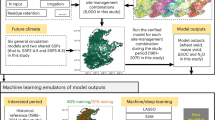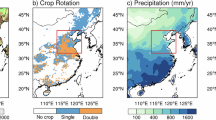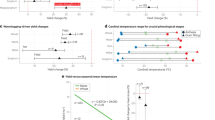Abstract
Crop migration can moderate the impacts of global warming on crop production, but its feedback on the climate and environment remains unknown. Here we develop an integrated framework to capture the climate impacts and the feedback of adaptation behaviours with the land–water–energy–carbon nexus perspective and identify opportunities to achieve the synergies between climate adaptation and environmental sustainability. We apply the framework to assess wheat and maize migration in the North China Plain and show that adaptation through wheat migration could increase crop production by ~18.5% in the 2050s, but at the cost of disproportional increment in land use (~19.2%), water use (~20.2%), energy use (~19.5%) and carbon emissions (~19.9%). Irrigation and fertilization management are critical mitigation opportunities in the framework, through which wheat migration can be optimized to reduce the climatic and environmental impacts and avoid potential carbon leakage. Our work highlights the sustainable climate adaptation to mitigate negative environmental externalities.
This is a preview of subscription content, access via your institution
Access options
Access Nature and 54 other Nature Portfolio journals
Get Nature+, our best-value online-access subscription
27,99 € / 30 days
cancel any time
Subscribe to this journal
Receive 12 digital issues and online access to articles
118,99 € per year
only 9,92 € per issue
Buy this article
- Purchase on SpringerLink
- Instant access to full article PDF
Prices may be subject to local taxes which are calculated during checkout





Similar content being viewed by others
Data availability
Historical climate data are from National Meteorological Information Centre of China (https://data.cma.cn/en); future climate data are from ISIMIP3b (https://www.isimip.org/); county-level agricultural data are mainly from Xu et al.13, obtained from Agricultural Information Institute of Chinese Academy of Agricultural Sciences (http://aii.caas.net.cn/); country-level agricultural data for trade scenarios are mainly from FAOSTAT (https://www.fao.org/faostat/en/#data). All the data that support the crop migration simulation and scenario analyses of this study are from public sources clearly referenced in the main text and Supplementary Information. Source data are provided with this paper.
Code availability
The Stata 14.0 and R 3.5.1 codes and Microsoft Office Suite 2019 used for data processing, analysis and visualization during the current study are available from the corresponding author upon reasonable request.
References
Lobell, D. B. & Field, C. B. Global scale climate–crop yield relationships and the impacts of recent warming. Environ. Res. Lett. 2, 014002 (2007).
Cohn, A. S., VanWey, L. K., Spera, S. A. & Mustard, J. F. Cropping frequency and area response to climate variability can exceed yield response. Nat. Clim. Change 6, 601–604 (2016).
Cui, X. M. Climate change and adaptation in agriculture: evidence from US cropping patterns. J. Environ. Econ. Manag. 101, 102306 (2020).
Sloat, L. L. et al. Climate adaptation by crop migration. Nat. Commun. 11, 1243 (2020).
Yang, X. et al. Adaptation of agriculture to warming in Northeast China. Clim. Change 84, 45–58 (2007).
Enriquez-de-Salamanca, A., Diaz-Sierra, R., Martin-Aranda, R. M. & Santos, M. J. Environmental impacts of climate change adaptation. Environ. Impact Assess. 64, 87–96 (2017).
Fezzi, C., Harwood, A. R., Lovett, A. A. & Bateman, I. J. The environmental impact of climate change adaptation on land use and water quality. Nat. Clim. Change 5, 255–260 (2015).
Yang, Y., Liu, B. B., Wang, P., Chen, W. Q. & Smith, T. M. Toward sustainable climate change adaptation. J. Ind. Ecol. 24, 318–330 (2020).
Gu, W. Y., He, W. F., Su, H. S. & Liu, B. B. Prioritizing climate change adaptation needs for hydropower sector in China. Environ. Res. Lett. 17, 034040 (2022).
Rasul, G. & Sharma, B. The nexus approach to water–energy–food security: an option for adaptation to climate change. Clim. Policy 16, 682–702 (2016).
Bleischwitz, R. et al. Resource nexus perspectives towards the United Nations Sustainable Development Goals. Nat. Sustain. 1, 737–743 (2018).
Xie, W. et al. Crop switching can enhance environmental sustainability and farmer incomes in China. Nature 616, 300–305 (2023).
Xu, Z. C. et al. Impacts of irrigated agriculture on food–energy–water–CO2 nexus across metacoupled systems. Nat. Commun. 11, 5837 (2020).
Jeong, S. J. et al. Effects of double cropping on summer climate of the North China Plain and neighbouring regions. Nat. Clim. Change 4, 615–619 (2014).
Fan, X., Zhang, W., Chen, W. W. & Chen, B. Land–water–energy nexus in agricultural management for greenhouse gas mitigation. Appl. Energ. 265, 114796 (2020).
Daccache, A., Ciurana, J. S., Diaz, J. A. R. & Knox, J. W. Water and energy footprint of irrigated agriculture in the Mediterranean region. Environ. Res. Lett. 9, 124014 (2014).
Qiu, G. Y., Zhang, X. N., Yu, X. H. & Zou, Z. D. The increasing effects in energy and GHG emission caused by groundwater level declines in North China’s main food production plain. Agric. Water Manag. 203, 138–150 (2018).
Chen, X. Z., Wang, P. X., Muhammad, T., Xu, Z. C. & Li, Y. K. Subsystem-level groundwater footprint assessment in North China Plain—the world’s largest groundwater depression cone. Ecol. Indic. 117, 106662 (2020).
Rothausen, S. G. S. A. & Conway, D. Greenhouse-gas emissions from energy use in the water sector. Nat. Clim. Change 1, 210–219 (2011).
FAOSTAT. Food and Agriculture Organization https://www.fao.org/faostat/en/#data/TCL (2022).
Lange, S. Trend-preserving bias adjustment and statistical downscaling with ISIMIP3BASD (v1.0). Geosci. Model Dev. 12, 3055–3070 (2019).
Tian, D. et al. The effect of drip irrigation and drip fertigation on N2O and NO emissions, water saving and grain yields in a maize field in the North China Plain. Sci. Total Environ. 575, 1034–1040 (2017).
González, M. E. et al. Evaluation of biodegradable polymers as encapsulating agents for the development of a urea controlled-release fertilizer using biochar as support material. Sci. Total Environ. 505, 446–453 (2015).
Abalos, D., Jeffery, S., Sanz-Cobena, A., Guardia, G. & Vallejo, A. Meta-analysis of the effect of urease and nitrification inhibitors on crop productivity and nitrogen use efficiency. Agric. Ecosyst. Environ. 189, 136–144 (2014).
Xia, L. et al. Can knowledge-based N management produce more staple grain with lower greenhouse gas emission and reactive nitrogen pollution? A meta-analysis. Global Change Biol. 23, 1917–1925 (2017).
Li, H. et al. Drip fertigation significantly increased crop yield, water productivity and nitrogen use efficiency with respect to traditional irrigation and fertilization practices: a meta-analysis in China. Agric. Water Manag. 244, 106534 (2021).
Liu, J. G. et al. Nexus approaches to global sustainable development. Nat. Sustain. 1, 466–476 (2018).
Romeiko, X. X., Lee, E. K., Sorunmu, Y. & Zhang, X. S. Spatially and temporally explicit life cycle environmental impacts of soybean production in the US Midwest. Environ. Sci. Technol. 54, 4758–4768 (2020).
Xia, L. L. et al. Integrated biochar solutions can achieve carbon-neutral staple crop production. Nat. Food 4, 236–246 (2023).
Elrys, A. S. et al. Expanding agroforestry can increase nitrate retention and mitigate the global impact of a leaky nitrogen cycle in croplands. Nat. Food 4, 109–121 (2023).
Wang, X. H. et al. Global irrigation contribution to wheat and maize yield. Nat. Commun. 12, 1235 (2021).
Caldera, U., Sadiqa, A., Gulagi, A. & Breyer, C. Irrigation efficiency and renewable energy powered desalination as key components of Pakistan’s water management strategy. Smart Energy 4, 100052 (2021).
Liu, B. & Yang, Y. Large benefits of timely planting. Nat. Food 3, 495–496 (2022).
Allen, R. G., Pereira, L. S., Raes, D. & Smith, M. Crop Evapotranspiration: Guidelines for Computing Crop Requirements. Irrigation and Drainage Paper No. 56 (Food and Agriculture Organization, 1998).
Xue, J. et al. Quantification of wheat water footprint based on data assimilation of remote sensing and WOFOST model. Agr. Forest Meteorol. 347, 109914 (2024).
Liu, B. B. et al. Promoting potato as staple food can reduce the carbon–land–water impacts of crops in China. Nat. Food 2, 570–577 (2021).
Wang, J. X. et al. China’s water-energy nexus: greenhouse-gas emissions from groundwater use for agriculture. Environ. Res. Lett. 7, 014035 (2012).
Linquist, B., van Groenigen, K. J., Adviento-Borbe, M. A., Pittelkow, C. & van Kessel, C. An agronomic assessment of greenhouse gas emissions from major cereal crops. Global Change Biol. 18, 194–209 (2012).
The Intergovernmental Panel on Climate Change (IPCC). 2019 Refinement to the 2006 IPCC Guidelines for National Greenhouse Gas Inventories (IPCC, 2019).
Tian, X. S. et al. Bottom-up estimates of reactive nitrogen loss from Chinese wheat production in 2014. Sci. Data 9, 233 (2022).
Zhu, L. Y. & Aguilera, P. Evaluating variations in tropical cyclone precipitation in Eastern Mexico using machine learning techniques. J. Geophys. Res. Atmos. 126, e2021JD034604 (2021).
Chen, S. A., Chen, X. G. & Xu, J. T. Impacts of climate change on agriculture: evidence from China. J. Environ. Econ. Manag. 76, 105–124 (2016).
Mendelsohn, R. O. & Massetti, E. The use of cross-sectional analysis to measure climate impacts on agriculture: theory and evidence. Rev. Environ. Econ. Policy 11, 280–298 (2017).
Fezzi, C. & Bateman, I. The impact of climate change on agriculture: nonlinear effects and aggregation bias in Ricardian models of farmland values. J. Assoc. Environ. Resour. 2, 57–92 (2015).
Jagermeyr, J. et al. Climate impacts on global agriculture emerge earlier in new generation of climate and crop models. Nat. Food 2, 873–885 (2021).
Vejan, P., Khadiran, T., Abdullah, R. & Ahmad, N. Controlled release fertilizer: a review on developments, applications and potential in agriculture. J. Control. Release 339, 321–334 (2021).
Zhang, L. et al. Integrated assessment of agronomic, environmental and ecosystem economic benefits of blending use of controlled-release and common urea in wheat production. J. Clean. Prod. 287, 125572 (2021).
Hasegawa, T. et al. A global dataset for the projected impacts of climate change on four major crops. Sci. Data 9, 58 (2022).
Heffer, P. Assessment of Fertilizer Use by Crop at the Global Level (International Fertilizer Industry Association, 2013).
Fan, Y., Li, H. & Miguez-Macho, G. Global patterns of groundwater table depth. Science 339, 940–943 (2013).
Acknowledgements
The research was supported by the National Natural Science Foundation of China (grant 72174085 to B.L. and 71921003 to J.B.) and Jiangsu Provincial Department of Science and Technology (grant BK20221448 and BK20220012 to B.L.). W.G. acknowledges support from Peking University-BHP Carbon and Climate Wei-Ming PhD Scholars (WM202306). We also thank B. Lu (Nanjing University) and Y. Xue (Nanjing University) for their effort into the visualization of this study. We acknowledge the support from the Independent Project of State Key Laboratory of Pollution Control and Resource Reuse.
Author information
Authors and Affiliations
Contributions
B.L. and W.G. designed the research study. G.M., W.G. and R.W. performed the analyses, with additional support from L.X. for the meta-analysis. W.G., G.M. and R.W. produced the figures. W.G. and G.M. wrote the original draft; L.S., P.H., Y.Z., J.B. and B.L. further revised the manuscript.
Corresponding authors
Ethics declarations
Competing interests
The authors declare no competing interests.
Peer review
Peer review information
Nature Food thanks Shiliang Liu, Shu Kee Lam and the other, anonymous, reviewer(s) for their contribution to the peer review of this work.
Additional information
Publisher’s note Springer Nature remains neutral with regard to jurisdictional claims in published maps and institutional affiliations.
Supplementary information
Supplementary Information
Supplementary Sections 1 (Penman–Monteith equation), 2 (Supplementary Tables 1–45) and 3 (Supplementary Figs. 1–16 and references).
Source data
Source Data Fig. 2
County-level land–water–energy–carbon nexus of wheat production in NCP in 2010.
Source Data Fig. 3
Environmental implications associated with climate impacts and adaptation.
Source Data Fig. 4
The environmental impact analysis for projected wheat production in NCP in the 2050s under various scenarios.
Source Data Fig. 5
Environmental impacts of international wheat trade versus self-sufficiency in NCP.
Rights and permissions
Springer Nature or its licensor (e.g. a society or other partner) holds exclusive rights to this article under a publishing agreement with the author(s) or other rightsholder(s); author self-archiving of the accepted manuscript version of this article is solely governed by the terms of such publishing agreement and applicable law.
About this article
Cite this article
Gu, W., Ma, G., Wang, R. et al. Climate adaptation through crop migration requires a nexus perspective for environmental sustainability in the North China Plain. Nat Food 5, 569–580 (2024). https://doi.org/10.1038/s43016-024-01008-8
Received:
Accepted:
Published:
Issue Date:
DOI: https://doi.org/10.1038/s43016-024-01008-8
This article is cited by
-
Concurrence of mining and climate change: environmental implications and mitigation strategies
Environmental Geochemistry and Health (2025)
-
Crop migration and environmental consequences
Nature Food (2024)



